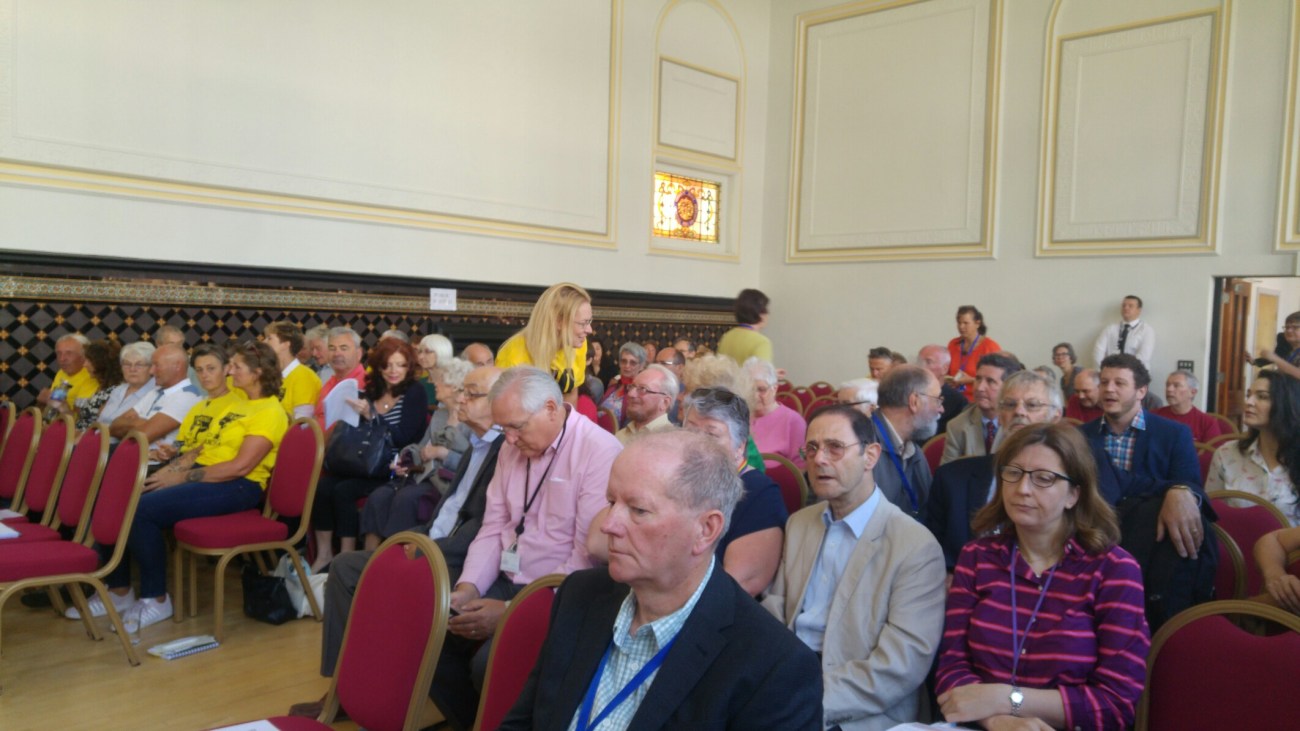
This post has live updates from the beginning of the second week of the public inquiry into plans by Ineos for shale gas exploration in the Derbyshire village of Marsh Lane. Today’s session will hear from the headteacher at the school in Marsh Lane near the site, along with Friends of the Earth and Campaign to Protect Rural England. Ineos will also open its case.
Ineos is seeking to drill a 2.4km deep vertical coring well using a 60m rig on land off Bramleymoor Lane. The company appealed against what it said was an unacceptable delay to the decision on the application by Derbyshire County Council. The council voted by nine to one to oppose the application.
The hearing in Chesterfield, is expected to last for eight days. The first week heard evidence from Derbyshire County Council and Eckington Against Fracking.
Background post on the inquiry and catch up on news from each day through links on the DrillOrDrop Marsh Lane inquiry page
Reporting from this inquiry has been made possible by individual donations from DrillOrDrop readers.
Key points from today’s hearing
- Marsh Lane parents will remove their children from the village primary school if the scheme goes ahead, the head teacher says.
- Risks of residents being kept awake by drilling are unacceptable, inquiry told
- The climate impacts of the scheme should be considered, says Friends of the Earth
- CPRE says there are no very special circumstances that justify siting the scheme in the Green Belt
- The Ineos application has strengthened the Marsh Lane community, resident tells inquiry
- Ineos well engineer says the proposed 60m rig would be the quietest available
- Drilling the Marsh Lane shale gas well would cost £6m, says Ineos
- Drilling during daytime only would cost an extra £2m and additional measures to cut noise would add another £1m, the company says
- Tom Pickering, for Ineos, says the company has “not shied away from community engagement”
- But admits local people have been opposed to the scheme from the beginning
- Ineos geologist tells inquiry the shale at Marsh Lane is likely to be more productive than in other parts of the basin
Additional reporting by Eddie Bisknell.
4.25pm: Inquiry adjourns
The inquiry resumes tomorrow (Wednesday 27 June 2018)
4.23pm: Dr Chris Hazel-Marshall
Dr Hazel-Marshall, the Ineos air quality witness gives his evidence to the inquiry.
He tells the inquiry the Marsh Lane shale gas scheme “will not have any significant impact on air quality”.
He says there has been no objection on these grounds from statutory consultees.
3.36pm: Cross-examination of Gareth Beamish by Derbyshire County Council
Richard Kimblin, barrister for Derbyshire County Council, asks Mr Beamish whether the shale in the East Midlands is “laterally extensive”.
Mr Beamish says at Marsh Lane, the shale has the potential to be commercially productive. He also says the shale at Marsh Lane is likely to be more productive than in other parts of the basin.
Mr Kimblin asks whether Ineos would have to explore all the PEDL licences it holds. Yes for a proper exploration, says Mr Beamish. There are extensive areas in which Ineos could place its exploration wells, Mr Kimblin suggests. Mr Beamish agrees.
Mr Kimblin asks whether exploration sites have been researched outside the Green Belt. Mr Beamish says this is outside his expertise. Have you seen any assessment looking at that issue, Mr Kimblin asks. No, says Mr Beamish.
Mr Kimblin asks if there were two exploration boreholes separated by miles, whether geologists could interpolate the geology between them. It depends, Mr Beamish says. If the rock intervals were continuous then they can, he says.
Is there any information to show why this location is preferable as a listening well than any other site, Mr Kimblin asks. Mr Beamish says it is only useful as a listening well if another well nearby is fracked. Mr Kimblin asks why the Marsh Lane site is preferable as a listening well. Mr Beamish says the site is not unique for this purpose.
3.21pm: Gareth Beamish gives evidence for Ineos

Gareth Beamish says he is a geologist and the sub-surface director for Ineos Upstream. He says he has 35 years experience in mining and oil and gas drilling. For the past 10 years he has managed shale gas developments. For Ineos, he has been involved in finding shale gas sites.
Mr Beamish says the same technology has been used in the Marsh Lane area for more than a century. He says groundwater aquifers have been protected from waste from the well.
The risk from former mineworkings is covered by regulations, he says. The presence of wartime ordnance has been discounted by surveys. The Coal Authority said there were no mineworkings on the site. Tremendous weight should be attached to this response, Mr Beamish says.
He says there are reports from drilling the 1987 well, some of the cuttings, “a plethora of information”. It is extremely important, he says.
The Bramleymoor-1 well is unique in that part of the East Midlands, he says. Most wells in the regions were drilled to penetrate the millstone grit. There are very few wells that go through the shale, he says. The Bramleymoor-1 well is one of the very few that goes through the shale, he says. It shows there is some potential for hydrocarbons. The metres are 150m apart so the geology is assumed to be the same, he says. I know what the succession of rock strata will be down to the depth of Bramleymoor-1.
“From a geological point of view, Bramleymoor is the best place to drill and core a shale gas well”
Mr Beamish says concerns raised by Professor Peter Styles are about fracking and have nothing to do with the inquiry, which is dealing with a vertical coring well only.
Asked about radon, Mr Beamish says the issue can be dealt with appropriately. It would not be a concern for the company, he says.
3pm: Return of aviation issues

Bob Hitchcock, the Eckington Against Fracking witness (pictured above), had raised aviation concerns in evidence to the inquiry. He tells the inquiry that each of these concerns have been addressed by Ineos. But to make that statement, he says
“I rely on the truthful presentation that has been given to me”.
Separately, David Kesteven wants to put another question to Ineos’s aviation expert. Mr Hitchcock says this is more of a planning issue.
The inspector, Elizabeth Hill, says EAF has had its chance to give its evidence. Mr Kesteven says his question is about the protection of airfields.
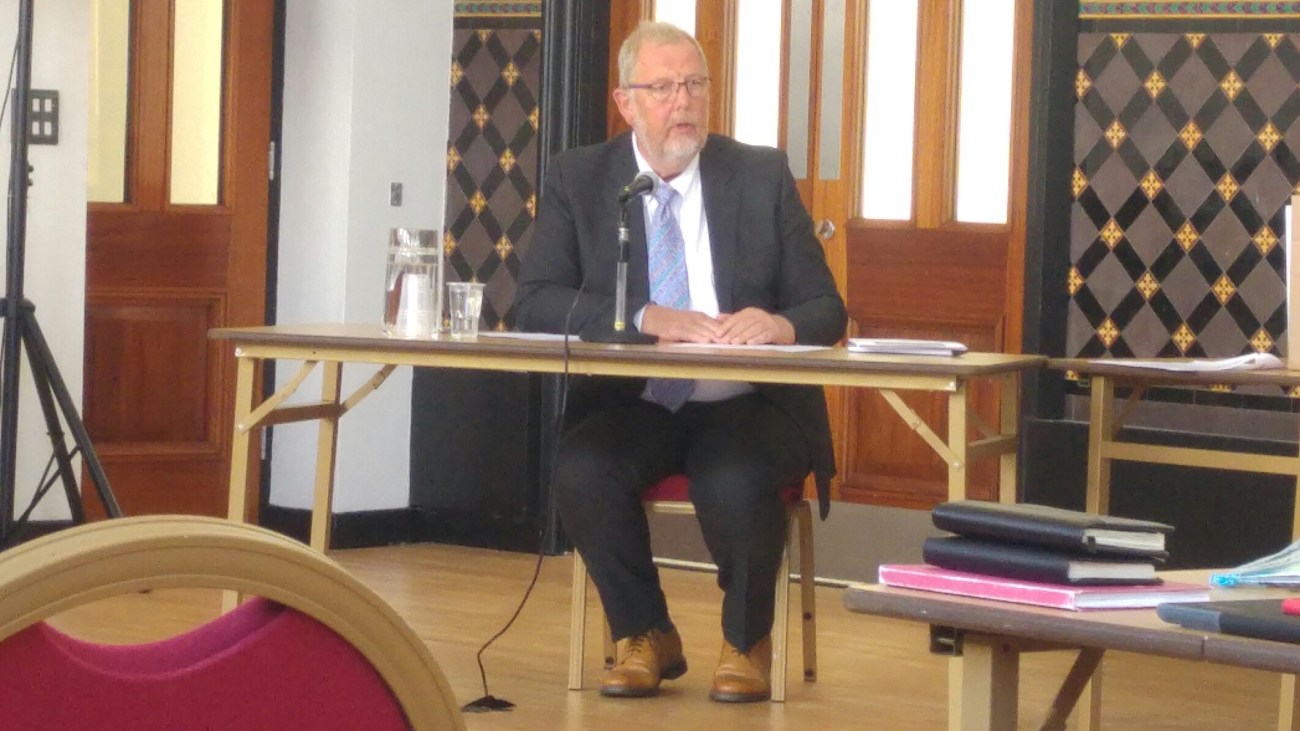
Mr Kesteven puts it to the Ineos aviation witness, Commander John Taylor (pictured above), that the regulations require airfields should be safeguarded. There is a 60m rig and the question is whether it would affect aviation safety. Commander Taylor says Coal Aston is an unlicensed aerodrome and no regulations apply to it. He says even if it would be licensed this would be perfectly manageable to operate. It is down to the flying skills of the pilot, he says.
With regards to aviation safety is this the right place for the well, Mr Kesteven asks. Commander Taylor says the well site is not incompatible with the operation of small aircraft.
2.46pm: More questions for Tom Pickering
Gordon Steele, for Ineos, asks Tom Pickering, the Ineos Operations Director, about whether the company has carried out study ground penetrative and stability studies. Mr Pickering says the ground penetrative radar picks out unexploded ordnance.
Mr Steele returns to the issue of noise mitigation at the Preston New Road shale gas site in Lancashire. Mr Pickering says the site operator proposed to install a 7m high noise attenuation barrier. That site would generate income from £7m from the extended flow test. The Marsh Lane site would not generate income, he adds.
Mr Pickering confirms to Mr Steele that he believes the “relevant company” has the capacity to meet any remediation costs.
2.45pm: Inquiry resumes
2pm: Break
The inquiry resumes at 2.45pm
1.12pm: Questions from the inquiry to Tom Pickering
1.54pm: Margaret Fry
Mrs Fry, chair of Eckington Town Team asks Mr Pickering whether he thinks people from the area were against the scheme from the beginning. He agrees.
She asks Mr Pickering why it chose the most scenic site in the area that can be seen for 30 miles. He says the site can be seen from a wide area but the proposed site is for a temporary operation.
People are not going to change their minds, Mrs Fry says. At my age, five years is not temporary.
She puts it to Mr Pickering that people’s lives have been disrupted. Mr Pickering says the rig is temporary. It is only there for a matter of months, he says.
1.52pm: Rachel Steele
Ms Steele, a resident of Coal Aston, asks Mr Pickering when Ineos wrote to Coal Aston Parish Council. He says he can’t answer this question. Ms Steele says there is no parish council for Coal Aston. She tells Mr Pickering the village is covered by Dronfield Town Council.
Ms Steele asks Mr Pickering why there was no event in Coal Aston when it would be “adversely affected” by the lorry route. Mr Pickering says the company has gone far beyond what it would be expected to do for any planning application.
1.50pm: Question on insurance
Mr Pickering says the Association of British Insurers sees no reason to have concerns about fracking and insurance.
1.45pm: Paul Glossop
Mr Glossop, a resident of Marsh Lane, says Ineos said 2,000 leaflets had been delivered in the vilage. Why did I not get one, Mr Glossop asks. Mr Pickering says “I don’t know”.
There are very clear guidelines on what we have to deal with on proximity to the site, Mr Pickering.
“We delivered to homes in the immediate proximity. That was the decision we made at the time.”
Mr Glossop asks which noise sensitive receptors had Ineos met. Mr Pickering says he has given details of the efforts he has made to engage with the community.
Mr Glossop asks about the injunction sought by Ineos against protests at its sites. Mr Pickering says the injunction was put in place to give the company a greater ability to deal with that problem. The inspector says this is not relevant to her decision.
1.40pm: Radon gas question
Mr Pickering is asked about the high risk of radon gas in the area. Mr Pickering says the area is a radon gas risk area. You would have metres to watch for it. You would vent that out to the atmosphere. That would be a means of addressing it, Mr Pickering says.
Mr Pickering is asked about the issue of radioactive waste and where it would be treated. Mr Pickering says there are waste disposal and treatment plants throughout the UK. After treatment, it would be disposed of in a specialist landfill site.
1.36pm: Tracy Lund
Ms Lund asks how many noise-sensitive receptors has Mr Pickering met. Mr Pickering says he met Ms Lund. On wider engagement, he had met those who were close to the site or expressed a real concern. Our comms team has met with other people locally, he says.
How many equestrian businesses on the traffic route have you met, Ms Lund. Mr Pickering says he can’t answer this question. We have not actively sought out groups to discuss this, he says.
1.34pm: Dennis Harrison
Mr Pickering is asked about risk of unexploded ordnance. He says an investigation would take place if the area was in a risk zone.
1.30pm: Coal Aston Against Fracking
Mr Pickering is asked when Ineos consulted with Coal Aston. Mr Pickering says there wasn’t an event in Coal Aston. The company put out fliers and adverts in the local press, he says.
The group asks which local newspapers were used. Mr Pickering says the Derbyshire Times. The group says this is not the local paper. That is part of the problem, the group says. Mr Pickering says Ineos invited the parish council.
Mr Pickering is asked when the fliers were put out. He says he doesn’t have the date. He says he would have to confirm whether they were sent to Coal Aston. The group asks why the villagers would say they received no information. Mr Pickering says he can’t answer this.
The group puts it to Mr Pickering that engagement should have been a priority given that the company intends to suspend parking in Coal Aston.
1.20pm Derek Ross
Mr Ross asks Mr Pickering why the first meeting was unfriendly. Mr Pickering says it was an extremely sensitive subject around which there is a great deal of misinformation. There are people expressing outrage at our proposals, he says.
Mr Pickering says:
“After that first meeting 150 people shouted “get out Tom”. It was pretty intimidating if you are Tom.”
Mr Ross asks if Mr Pickering has sympathy for the community.
“Of course, I do. You will not find many company directors who have met the community in person. I have not left it to a slick PR machine. I have met people in person.”
Asked about the school visit to the site, Mr Pickering says:
“The reason we have not taken people to the site is that we can deal with only one group. There is not one group entirely sanctioned by the community.”
Mr Ross asks whether the 1987 exploration the size of that proposed for the Ineos site. I guess they would have been very similar, Mr Pickering says. Mr Ross says it was a mobile drilling rig. Mr Pickering says a truck-mounted drilling rig would not be able to drill that depth of the well.
Mr Ross says the 1987 scheme was not for five years. Mr Pickering says the investment would justify using the site as a listening well, which explains the reason for a five year application.
Mr Ross asks why Ineos has not come up with a more environmentally-friendly alternative to fossil fuels. Mr Pickering says the intensive nature of its facilities require the ability to function 24-hour a days, which can be provided by gas. Society requires the everyday materials that need plastic, he says. Gas as a fossil fuel is very useful and is cleaner than coal, Mr Pickering adds.
“When the wind doesn’t blow or the sun doesn’t shine, it is our gas powered turbines that pick up the load. It is not possible to run an industrial facility on renewable technology.”
1.12pm Stephanie Butcher
Ms Butcher asks Mr Pickering about what advice Ineos has sought about being a good neighbour and engaging with the community. Mr Pickering says Ineos has advisers on social media, planning engagement meetings and media support. Have you sought external advice on how to communicate with this community. Mr Pickering says contractors have given advice across the UK.
Ms Butcher asks:
On a scale from 0-10, where do you feel you are with this community, where 0 is where you feel you have antagonised a community and 10 is where you feel you are well engaged.
Mr Pickering says this is an extremely sensitive issue and despite an enormous amount of work we are still at the low level, say 1 or 2.
Ms Butcher asks if he feels he would have done something differently. Mr Pickering says it is hard to know what the company might have done differently.
13.01pm: Cross-examination of Tom Pickering by Eckington Against Fracking
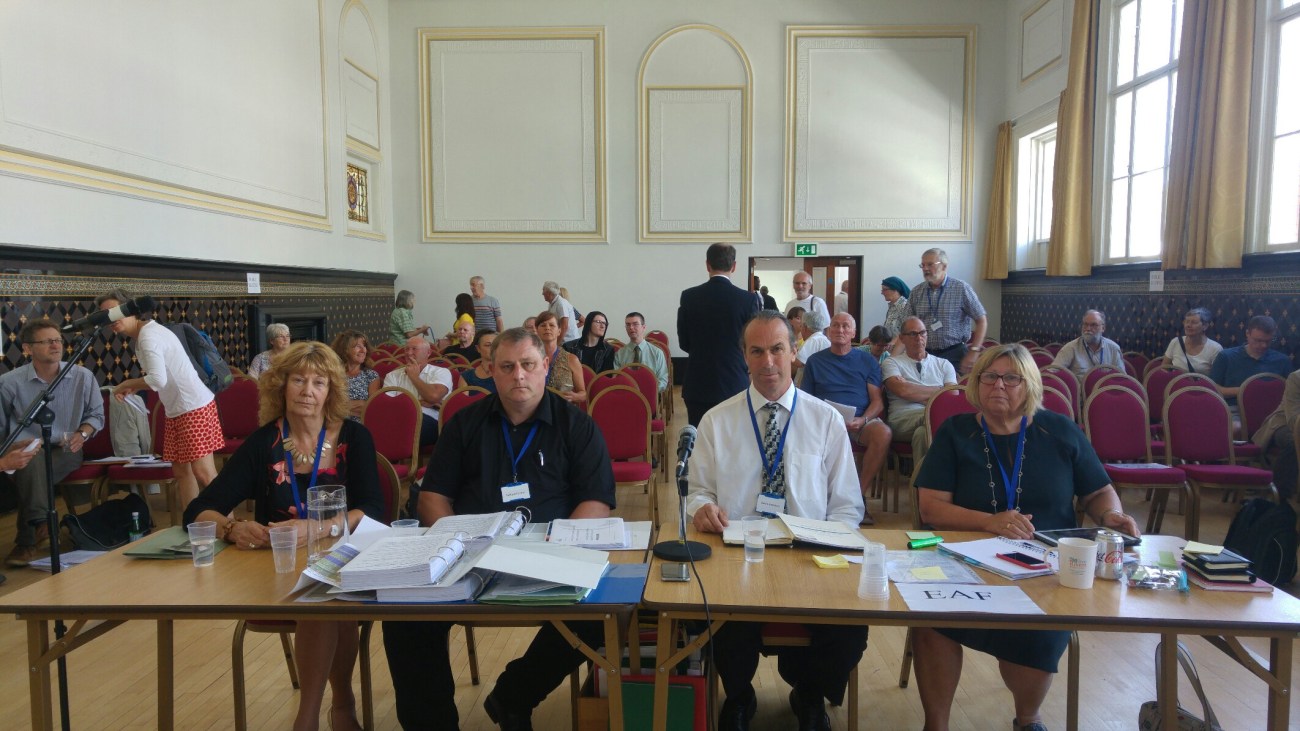
Eckington Against Fracking team at the Marsh Lane public inquiry, 26 June 2018.
David Kesteven, for Eckington Against Fracking, puts it to Mr Pickering that Ineos could use data from the many other wells drilled in the area. The company had said the available data from drilling near the Marsh Lane site was vital to the choice of the site. Mr Pickering says data from other wells would be used.
Talking to the community
Mr Kesteven refers to the evidence from the Marsh Lane headteacher, Fiona Marsh. She said there had been no further contact with the company after its offers for two-way dialogue.
Mr Pickering says he has attended meetings in the community. The first one was not particularly friendly, he says. Ineos continued to come back. Mr Pickering says:
“I have consistently asked for a community liaison group but that has not been forthcoming because people did not want to sit down with us or an emerging group that was willing to engage in that way. There has been no attempt to shy away from engagement.”
Mr Kesteven puts it to Mr Pickering that the benefits of any shale gas will go to Ineos. Mr Pickering says if ethane is present it would be used in its chemical works for use in plastics.
Mr Kesteven puts it to Mr Pickering that landowners were under the impression that the gas would be used “to keep the lights on” in case the Russians stopped supplying the UK.
Mr Pickering says he was not at a meeting with landowners. He says the presence of ethane would be of interest to Ineos business. The company already produces more gas that it needs from the North Sea.
The application is to establish whether there is gas, in what quantity and whether it would be commercial, Mr Pickering says.
Finances
Mr Pickering says Ineos Upstream is part of the Ineos Group. He tells the inquiry he is a director of Ineos Upstream and of several other Ineos companies.
I am concerned that these companies will be wound up if things go wrong and the site will be without indemnity, Mr Kesteven. Should Ineos have indemnity?, he asks.
For this well, there is more than sufficient funding for remediation in the Ineos Industries.
12.37pm: Cross-examination of Tom Pickering by Derbyshire County Council
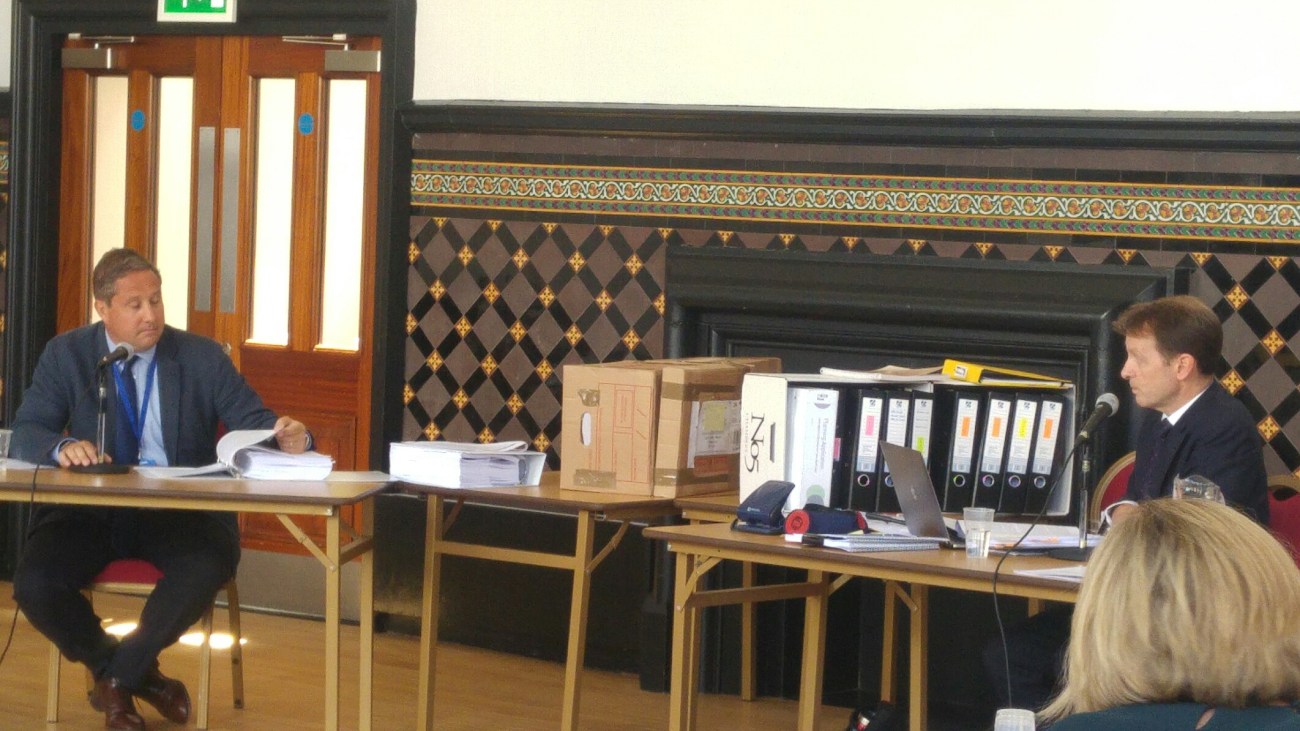
Richard Kimblin, barrister for Derbyshire County Council, asks where does Tom Pickering refer in his evidence about the great weight he gives to the previous well drilled in the area. Mr Pickering it is not in his evidence. It is in evidence from another Ineos witness.
Mr Kimblin asks whether the shale gas formation is extensive. Mr Pickering agrees that it is.
Reducing noise levels
Mr Kimblin asks about the cost of mitigating noise from drilling.
Mr Pickering says the cost of drilling the well would be around £6m.
Reducing noise levels would cost an extra £1m. This would be a significant cost, Mr Pickering says. This is information not previously before the inquiry, Mr Pickering agrees.
Previously, the inquiry heard it would cost £2m to restrict drilling to day time only.
Mr Kimblin refers to the inspector’s report on the Preston New Road appeal. In this case, Cuadrilla estimated installing acoustic barriers would cost £1.5m. The inspector in the PNR appeal said the additional costs were “meaningless” in the absence of any context from Cuadrilla.
Mr Kimblin suggests that the inspector at the Marsh Lane inquiry does not have the context either. Mr Pickering agrees. But he says sums of millions are not meaningless. It is an expensive operation. He agrees the costs are not set out.
Mr Kimblin asks what capital is available. Mr Pickering says judgements are not based on what capital is available.
Mr Kimblin says the inspector has no details on the budget for the scheme. Mr Pickering says the inspector should look at what had been done in other planning applications. Mr Kimblin asks whether they bear on the “unreasonable cost” of extra noise mitigation. Mr Pickering says they are wider considerations.
Mr Kimblin asks whether this well would provide enough information. Mr Pickering says Ineos would need information from about four vertical wells, two of which might be in the licence area, PEDL300.
Rig selection
Mr Pickering tells the inquiry the criteria for selection are standard in the drilling industry.
Richard Kimblin, for Derbyshire County Council, puts it to Mr Pickering that the company will consider first capability, safety and then environmental environmental. Mr Pickering agrees. “You weigh up quite a number of factors”, Mr Pickering says. It depends on what options are in the market place, he adds. He also says safety is paramount. This is something you plan for.
It is not true to say the rig will be the quietest, only that it will be quietest consistent with other factors. Mr Pickering agrees.
12.19pm: Tom Pickering gives evidence for Ineos
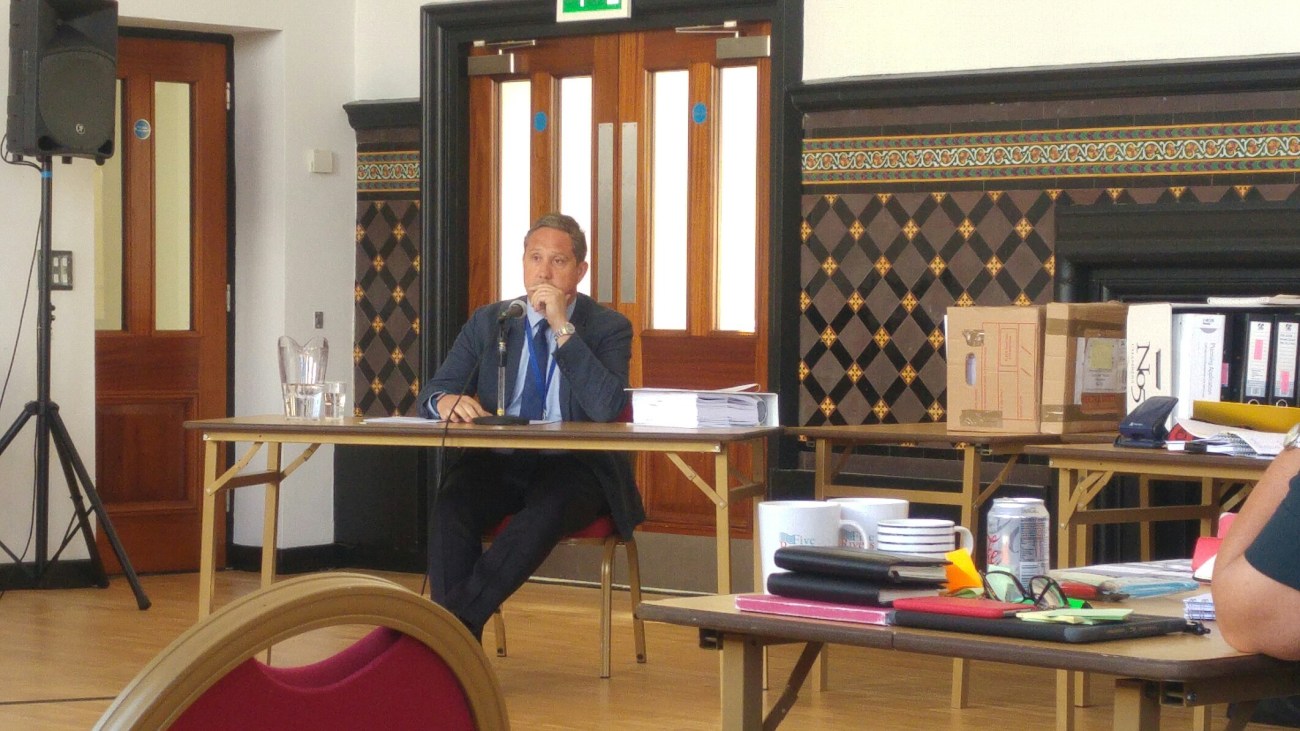
Tom Pickering tells the inquiry he is Operations Director for Ineos.
He says Ineos is one of the biggest chemical company in the world. It established Ineos Upstream to source energy and raw materials for its chemicals business. These include plastics, he says, and products that allow the UK to reduce its carbon footprint.
The benefits of shale gas have been challenged because the exploration well will not produce any gas. But he says exploration is an integral part of production.
The site selection process confirms the Bramleymoor Lane site is the most suitable based on geology, proximity to sensitive receptors and other issues, he says.
Greenhouse gas emissions would be negligible, he says.
The licence requires Ineos to maximize production from the area. It is not currently known whether production will occur from the site or from others where the geology is more suitable, Mr Steele says.
Ineos is privately-owned, well-funded and highly unlikely to fail,Mr Pickering says. After five years, the site would be restored and returned to the landowner unless another application is submitted, he says.
Works would not start on site for exploration until all the necessary permits were in place, Mr Pickering says.
Ineos aims to meet or where practical exceed all necessary requirements. Its operations across the world are best in class when measured against it peers, Mr Pickering says.
Ineos works closely with community groups to be a good neighbour, he adds.
If future appraisal or production proposals were brought forward they would require another application. Ineos would continue to actively engage with the local community.
Mr Pickering says Ineos would tender for the rig in the market place. He says the Marsh Lane site may or may not be suitable for fracking.
Ineos understands the legitimate concerns of the local community, Mr Pickering says. It undertook a large consultation process, including two exhibitions, attendance at meetings and meeting the parish council. The company would participate in a community liaison group if the application was approved.
Gordon Steele, the Ineos barrister, asks Mr Pickering about the previous well drilled near the site. Mr Pickering says
“We place a great deal of weight to offset well data. To have it so close to this site is an important part of our decision-making on data gathering and engineering design.”
He confirms it was “vitally important” to the choice of drilling at Marsh Lane.
Mr Steele asks about the income stream from the exploratory well. Mr Pickering says there would be no income. It would all be risk, he agrees. Data from the well is valuable but there is no income, he says.
12.11pm: More questions for Andrew Sloan
Gordon Steele, for Ineos, asks why there would be no NORM. Mr Sloan says there have been 700 wells drilled in the area which had not resulted in NORM.
Mr Sloan says he would not order the rig. He says the company would take account of a number of issues in doing so.
On day-time working, he says there are inefficiencies to not drilling 24-hours. The working hours would be more than double the length. There could also be safety and operational risks and more manual handling operations if drilling was done only during the day.
It is not ideal, he says.
12.10pm: Cross-examination of Andrew Sloan by CPRE
Dr Andy Tickle asks whether there will be any NORM returning to the surface with the drilling fluids and how they will be treated on site. Mr Sloan says he does not anticipate any NORM. If there were NORM in the cuttings they would go off-site to a specialist facility.
12.03pm: Cross-examination of Andrew Sloan by Eckington Against Fracking

Photo: Eddie Bisknell
David Kesteven, of Eckington Against Fracking (right), asks Andrew Sloan about the proposed blow-out preventer to be installed at the site. Mr Sloan says this is to prevent an explosion.
Mr Kesteven asks about the geology previously drilled into near the proposed site. Mr Sloan says there are no porous rocks and there was no gas flow.
On choice of rigs, Mr Sloan says the height will be part of the assessment process.
Mr Kesteven asks whether the vertical well bore could be fracked. Mr Sloan says it is not part of the planning application to do that. To move to the appraisal stage would need another well. Mr Sloan agrees.
11.49am: Cross–examination of Andrew Sloan by Derbyshire County Council
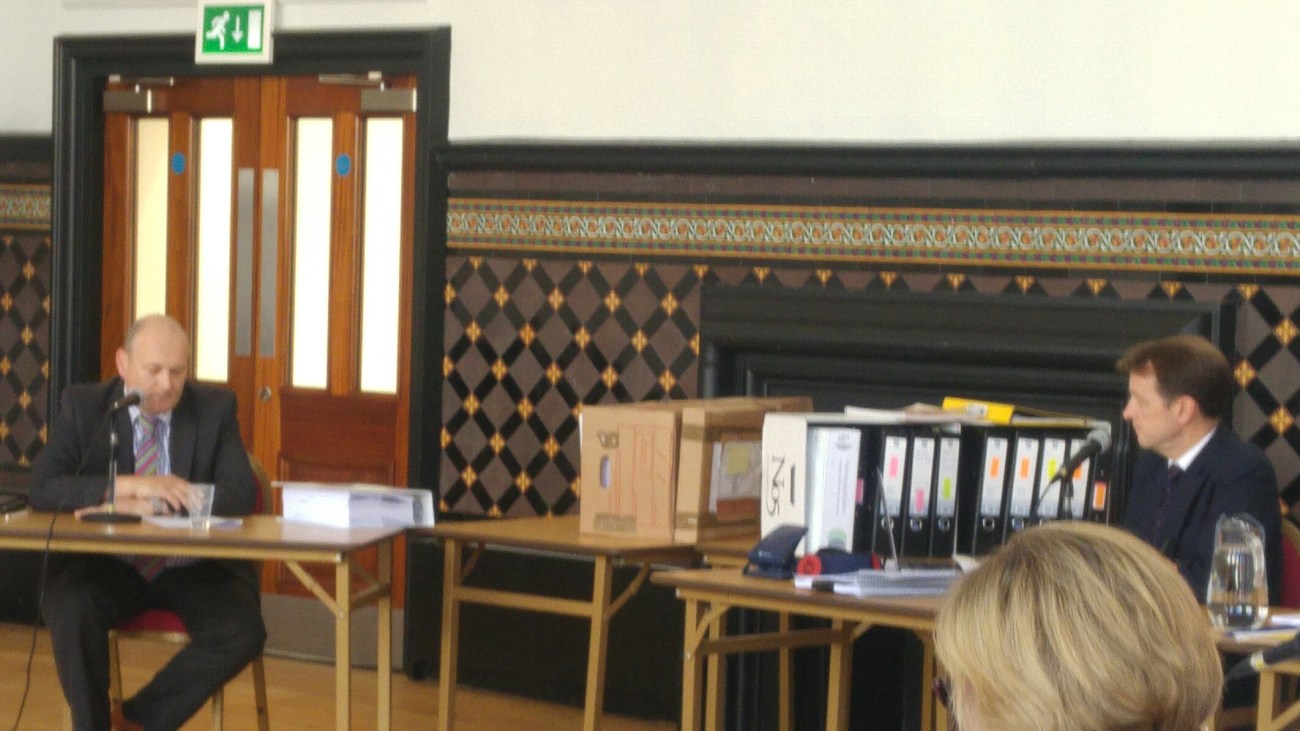
Rig selection
Richard Kimblin, barrister for Derbyshire County Council, asks what would affect decisions on choosing the rig.
Andrew Sloan, well engineer for Ineos, says the company would consider capability to drill and safety aspects, as well as commercial and environmental considerations. Mr Kimblin says capability and safety would be taken as read. You are left with a choice of the low or high cost. If you were in a hurry you might sacrifice environmental considerations. Mr Sloan agrees.
Mr Kimblin puts it to Mr Sloan that Ineos has not prioritised the reduction of noise from the rig.
“You have not explained how noise output is minimised. That’s because in your rig selection, noise output is not a matter yo have sought to minimise.”
Mr Sloan says the evaluation process is ongoing.
Where would the inspector find that information, Mr Kimblin asks. Good question, replies Mr Sloan.
Mr Sloan says a technical specification for the rig goes to contractors. Mr Kimblin asks whether this would be the quietest available. Mr Sloan agrees.
Mr Kimblin puts it to Mr Sloan that the cost of limiting drilling to day time would be about £2m. He asks if this is additional to the £3m drilling costs. Mr Sloan agrees. Mr Sloan adds that these costs are based on estimates from a contractor.
11.19am: Andrew Sloan gives evidence for Ineos

Mr Sloan says he is an independent well engineer.
He says he has 22 years in the oil and gas industry, mostly offshore in the UK and the US. He tells the inquiry the proposed Marsh Lane well is “extremely simple”. There is no reason that the well can’t be drilled safely, he says.
Mr Sloan says the regulatory system is based on a goal-setting regime, he says. This is not self-regulation, he adds.
He says the planning system should rely on the advice of the Health and Safety Executive.
Mr Sloan says rig selection is a complex business.
Well design
Well construction methodology planned at Marsh Lane is not novel or experimental, he says. It uses methods employed all over the world. The Health and Safety Executive (HSE) has had no comment on the well design.
He says the well will be drilled with “benign” water-based drilling fluids and sealed with layers of steel and cement. Any potential surface spills would be contained on the site. These methods reduce the risk of groundwater contamination, he says.
Mr Sloan says at least three layers of steel and cement protect the aquifer. Gordon Steele, for Ineos, says pollution would have to cross several inches of cement and three 3/4 inch steel casings. What are practical possibilities of that happening, Mr Steele asks. Extremely low probability, Mr Sloan says.
Mr Sloan adds that the well would be abandoned according to the regulations.
Emergencies, radon and mineworkings
A site safety plan would be submitted to the HSE, including an emergency response plan.
Mr Sloan says there will be detectors on the rig for radon. Operations would stop or contingency measures would be put in place. There is no reason to be concerned about radon, he adds.
Mr Sloan says Ineos has all the available data on mine workings.
Venting
On emergency venting of gas, he says this would be controlled by staff on the site and could be stopped at any time. Mr Sloan says venting should not be required at all. It is a “discrete event” caused by a small influx of gas into the well. He says:
“The risk of encountering hydrocarbons like that would be extremely low. It would be a one-off discrete event.”
Mr Sloan says gas would be vented from a 11m tank on the site, separate from the rig. It would not be under pressure, he says.
“It’s a bit like a coke bottle”
The gas would disperse into the atmosphere, he says. It would be inaccurate to say the gas would be under pressure at height from the wellhead. Venting would happen during the several months of drilling, he says.
11.18am: Ineos case begins
11.15am Professor Styles’ presentation
The inspector,Elizabeth Hill, says copies of Professor Styles’ presentation have been delivered to the inquiry. She invites Gordon Steele, for Ineos, to review the presentation.
Mr Steele says his witnesses need time to review the evidence and he doesn’t know when they will be available after today.
Elizabeth Hill says the presentation is now before the inquiry. She says Mr Steele should look at the evidence.
11am: Break
The inquiry resumes at 11.15am
10.47am: Tracy Lund gives evidence against the scheme
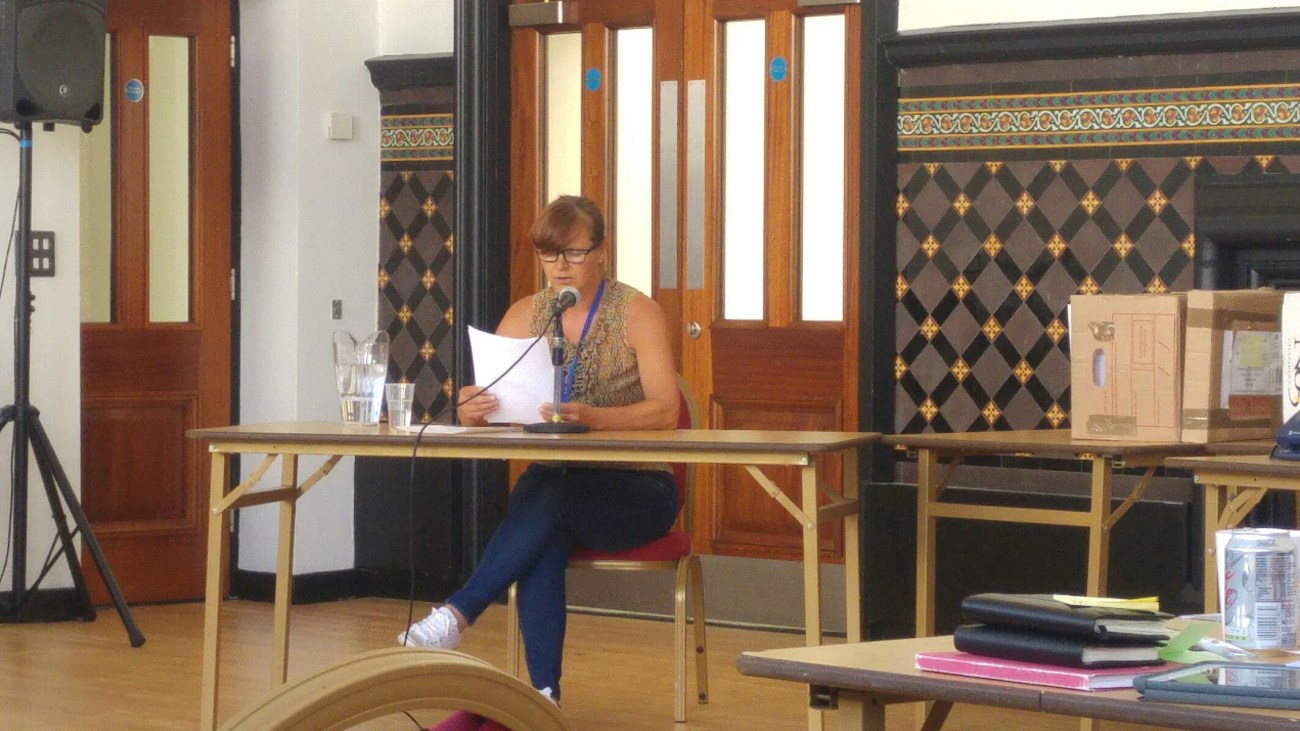
Ms Lund, a local resident and business owner, tells the inquiry the scheme is having an impact now.
Her plant nursery business for the first time in 15 years is operating at a loss because of the time she is spending time on the application, she says.
Ms Lund says her mother lives on Bramley Road and recent invested in a summer house. She now feels this is a waste of money because she will have to retreat inside if the scheme goes ahead.
There are no very special circumstances or need to develop the site in the Green Belt have been put forward by Ineos, Ms Lund says.
The scheme should be refused, she says, because it breaches planning policy.
Ms Lund says:
“This community is not weakened by the might of Ineos. It has strengthened in its resolve to protect our environment. Marsh Lane says no and it means no.”
Applause from the audience. The inspector says it is not acceptable to applaud in a public inquiry.
10.39am: Cross examination of Dennis Harrison
Gordon Steele, for Ineos, asks whether Mr Harrison has no formal qualifications in the area of his evidence. Mr Harrison says he has stated this in his presentation. Mr Steele says the expert body, Public Health England has no objection to the application.
Mr Harrison repeats his criticism of PHE as being naive for suggesting that the risk from a single well is small.
Mr Steele suggests that a waste facility would be heavily regulated. Mr Harrison says some of the waste facilities may not equipped of dealing with all radioactive contaminants. The contaminants have to go somewhere, he says. There are too many variables, he says. You are moving substances from deep in the ground to the surface, creating a radioactive corridor, he says.
Mr Harrison says Ineos evidence states there will be radon in flow back fluid.
Mr Steele suggests that Mr Harrison is using evidence from the US and evidence that relates to fracking. He says Mr Harrison is critical of the regulatory system.
Mr Steele asks if the regulatory system worked appropriately would that deal with Mr Harrison’s concerns. Mr Harrison says the regulators are not equipped or experienced in the process.
10.22am: Dennis Harrision gives evidence against the scheme
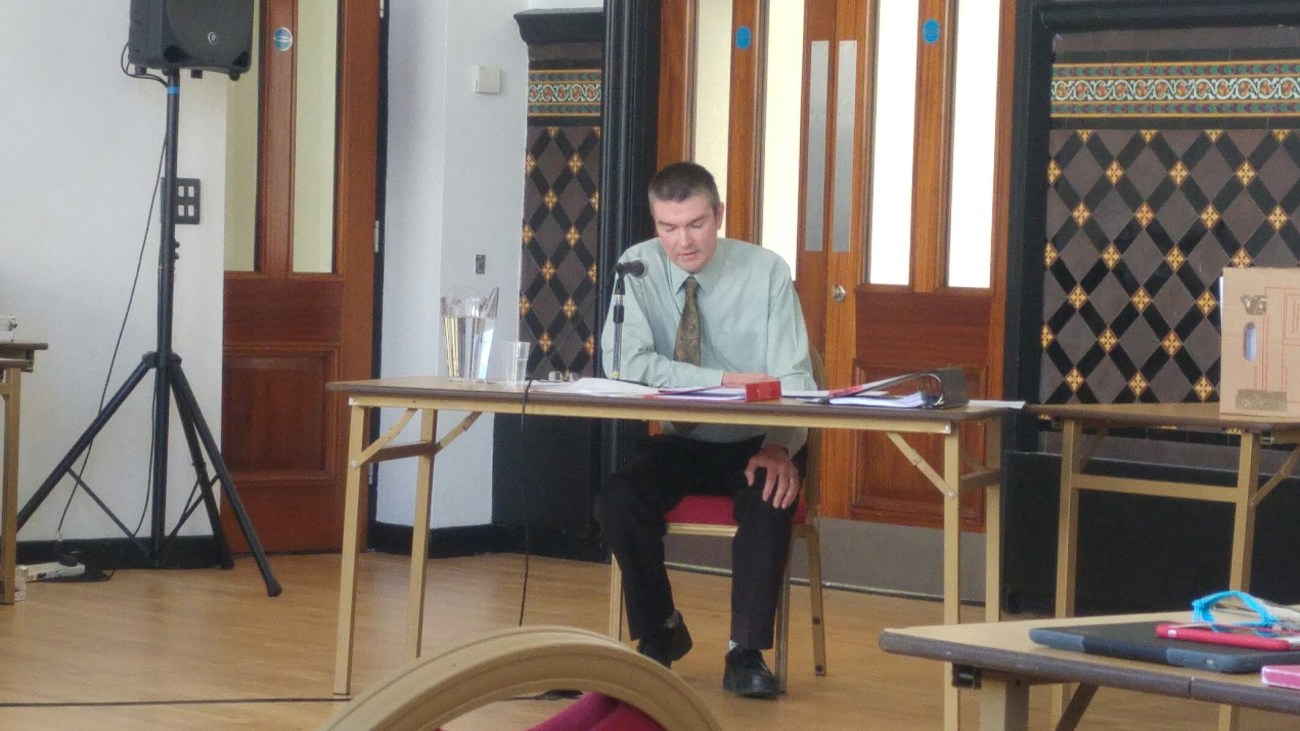
Mr Harrison describes himself as a concerned local residents of Marsh Lane. He says he is not a expert in radiation levels.
He says he has lived in Derbyshire all his life. He says he remembers public footpaths being closed in the 1970s because of high levels of radon.
Radon is the number one cause of lung cancer among non-smokers. Mr Harrrison says Derbyshire has some of the highest levels of radon in the UK. Shale gas drilling can increase exposure to radon and radioactivity, he says.
Mr Harrison says shale gas extraction can lead to displacement of what is known as TENORM, “technically enhanced naturally occurring radioactive materials”. The existence of TENORM results in an increased risk of human exposure to radioactivity, he says.
Mr Harrison says the radiation levels in the strata and waste may vary considerably. He says the waste is likely to go to the FCC facility at Ecclesfield in Sheffield. He asks about safeguards for protecting staff at the site from TENORM displacement and to prevent illegal dumping of waste.
The Ineos planning application does not refer to TENORM displacement. Mr Harrison says:
“There is a real danger that waste resulting from drilling activities will not be adequately processed.”
He quotes a report from the then Department of Energy and Climate Change which says there will be a need for additional waste treatment of Naturally Occurring Radioactive Material.
Mr Harrison says:
“The regulatory system, infrastructure and logistical arrangements, including company quality management systems, to deal with large quantities of contaminated waste are not adequately dealt with or considered in the planning application.”
He quotes scientific studies suggests exposure to radiation in the oil and gas industry could result in cancers.
But he is critical of the Public Health England review of health impacts of shale gas which suggested the risks of small-scale operations are expected to be small. Public Health England did say the cumulative impact of many wells in various phases were potentially greater.
Mr Harrison says the Public Health England report on shale gas health impacts is out-of-date and shows “naivitey”.
“In reality there is incomplete scientific knowledge about the risk of exposure to many of the latent chemical and radioactive hazards. There is even less knowledge about the potential risks associated with the effects of being exposed to multiple hazards simultaneously.”
The picture is emerging of potential health hazards for local communities and the local and wider environment, he says.
Since preparing this presentation, Mr Harrison says he has undertaken further research. This suggests that radon can travel some distance before it is detected. Samples of flowback from the Preese Hall exploration site showed the presence of radon. It is likely that radon will be present in flowback water, he adds.
Mr Harrison says three homes in Ridgeway, Marsh Lane, had radon levels above the 200 action level. Another 32 homes in Coal Aston, 69 in Dronfield south and 9 Unstone in were above that level. The testing was based on small samples. If all the homes had been surveyed, the numbers would rise to 30 homes in Ridgeway, Marsh Lane, 82 in Coal Aston, 198 in Dronfield south and 36 in Unstone. The highest level recorded was in Unstone at 1,400bq. The action level is 200.
10.21am: Cross-examination of Noella Dowling
Ms Dowling confirms it is a commonly-held belief that her road will become an alternative route for traffic.
10.17am: Noella Dowling
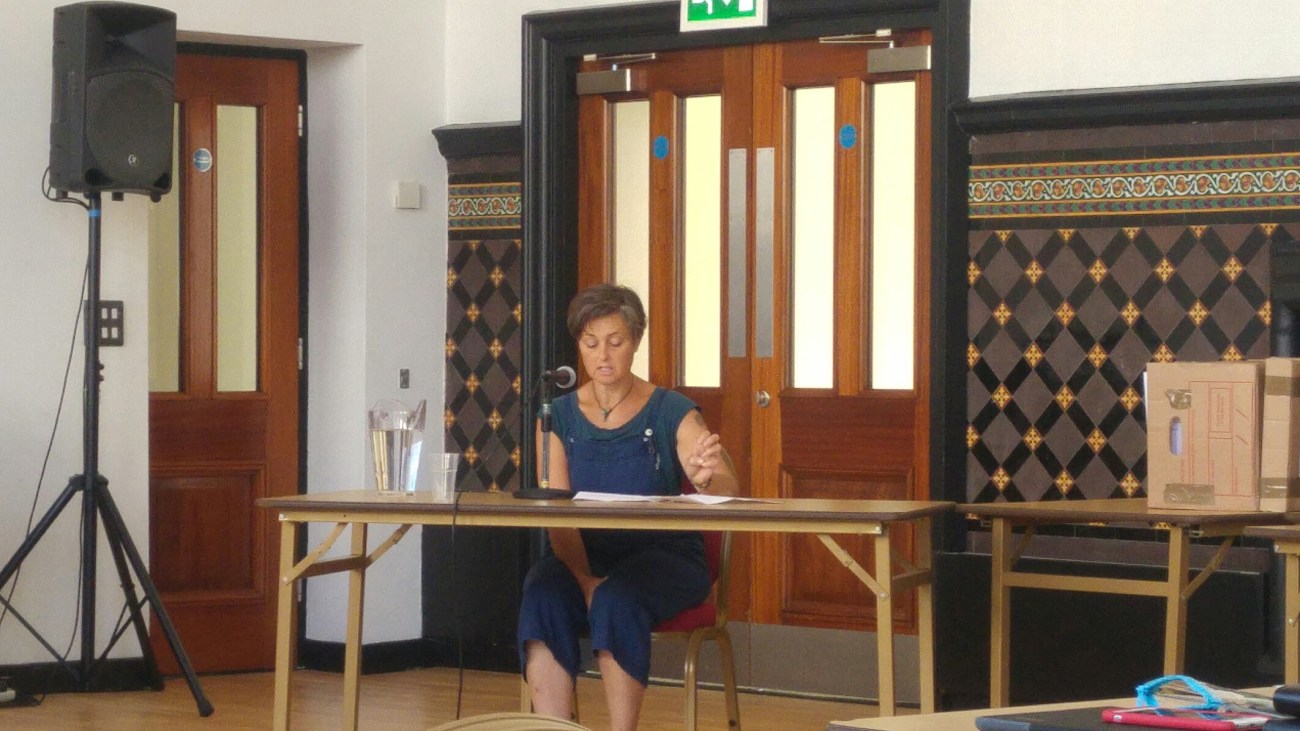
Ms Dowling tells the inquiry it was dream move when she relocated to Marsh Lane.
She needs quiet for her mental health. Sleeping with a fridge-freezer, as Ineos describes the night time drilling noise, would undo hard work she has undergone to improve her mental health issues.
She runs a yoga business from home, which would be disrupted, she tells the inquiry.
She is also concerned about increased traffic that would result from the scheme, possible pollution and the impact on previously mined land. She is concerned that her road will become an alternative traffic route.
10.06am: Fiona Marsh, headteacher
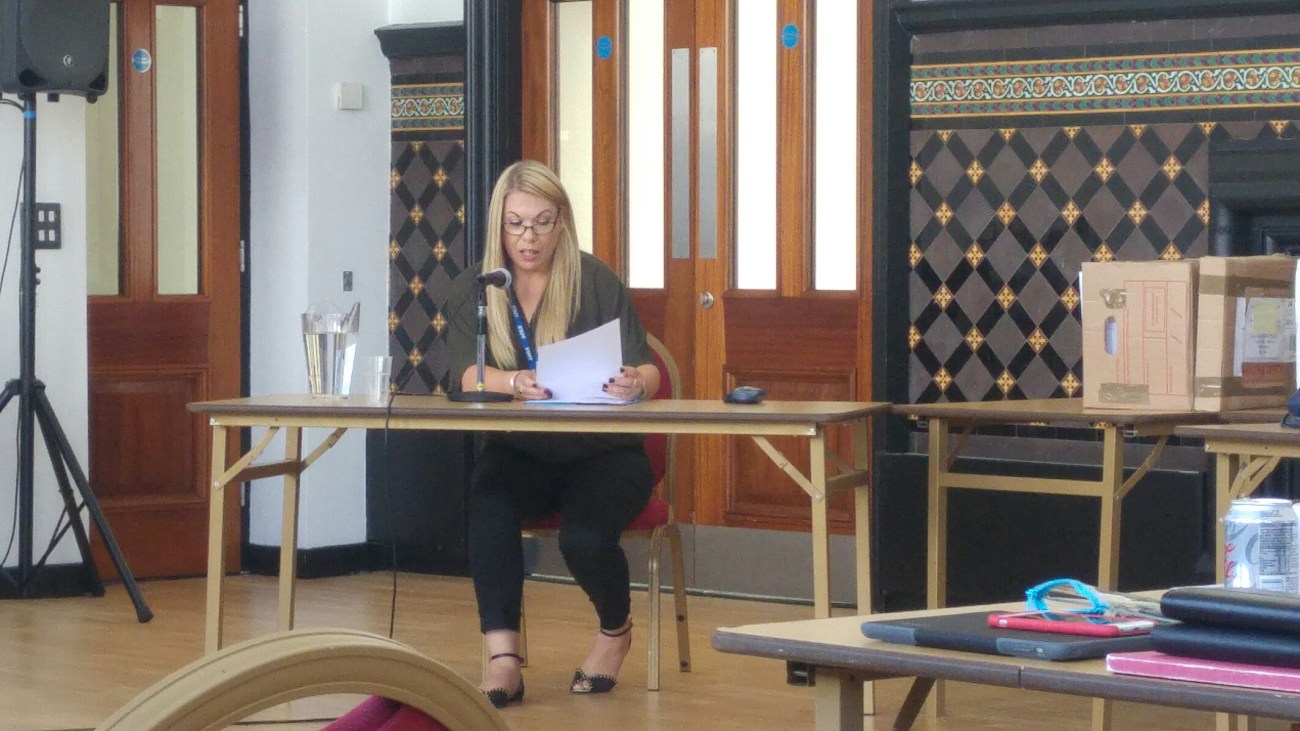
Ms Marsh is headteacher of Marsh Lane Primary School, which has 129 pupils.
She says she has contacted Ineos on several occasion about questions first raised in January. But Ineos has not answered them.
Ms Marsh says the questions have been raised by the school community.
The school was not contacted by the company before the application. Parents have said they would remove children from the school. Ms Marsh contacted the company. She was given information pamphlets and an email from an Ineos executive.
A meeting in January of school governors with an Ineos executive promised a visit to another company site. Ms Marsh says she followed this up but got no response and no visit has happened.
We have received no further correspondence with Ineos, she says.
The governors asked whether the close proximity to the site would cause damage to the school. They were concerned about drilling noise. Ineos related the noise to a fridge freezer, Ms Marsh says.
The school is less than a mile from the site and uses a closer playing field.
Ms Marsh says the school asked questions about traffic, the route and safety issue. The parents indicated that if the site was approved they would remove their children. This was raised with Ineos. The company was asked about risk assessments in an emergency, increased traffic and security. We would like a questions answered by Ineos, she says. We are disappointed that answers have not been provided, she adds.
The school has remained neutral and has not got involved in any anti-fracking campaign, she says.
9.59am: Cross-examination of Kate Gordon
Gordon Steele, for Ineos, suggests that Friends of the Earth also gave similar evidence to the Harthill appeal, which was allowed. Ms Gordon agrees.
Mr Steele again asks whether Ms Gordon agrees with the Written Ministerial Statement. Ms Gordon says she accepts that weight needs to be attached to that policy but weight also needs to be attached to other policies.
Mr Steele asks whether Friends of the Earth agrees with the policy. Ms Gordon says the organisation will respond to a consultation. We don’t consider shale gas is consistent with climate change targets, she says.
Mr Steele puts it to her that FoE is critical of the policy. Ms Gordon agrees. We don’t have the technology to address the emissions, she says.
On noise, Mr Steele asks whether Friends of the Earth is concerned about adverse impacts on human health. Ms Gordon says “we are not convinced that this can be controlled by conditions”. Three months of drilling at night at that level of noise could disturb sleep, she says.
Mr Steele says the limits proposed are consistent with World Health Organisation and Mineral Planning Policy guidance. Ms Gordon says there is a gap in the guidance. Three months of being kept awake at night is a serious health concern, she adds.
9.50am: Kate Gordon, Friends of the Earth
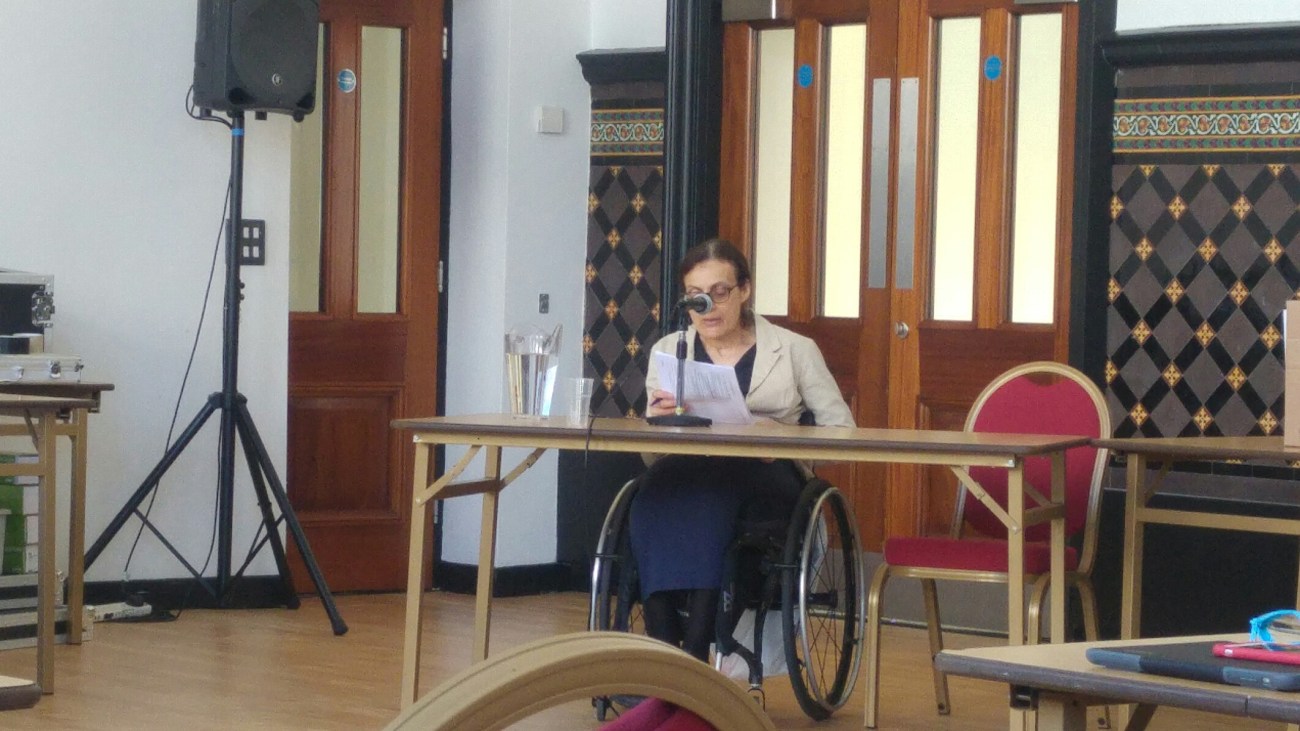
Kate Gordon is a senior planner with Friends of the Earth.
The organisation objected to the application and remains concerned that it represents unsustainable development, and is contrary to national planning policy. She says:
It would lead to unacceptable adverse impacts on local amenity and local residents.
Ms Gordon adds:
“This proposal fails to demonstrate any reduction in greenhouse gas emissions. Moreover it could potentially contribute to a new fossil fuel based industry becoming established in the UK for which there would be significant greenhouse gas emissions.”
Ms Gordon says there is no evidence that three tests applied by the Committee on Climate Change for shale gas to meet UK carbon budgets will be forthcoming.
Friends of the Earth argues “it would make no sense to ignore the nature of the future energy supply in question and impacts one might reasonably expected to arise from extracting and using it.”
“We consider the proposal needs to be considered holistically taking into account potential impacts from subsequent stages, the nature of the energy to be supplied and the ability of shale gas, as a fossil fuel, to deliver the radical reductions in greenhouse gas emissions which are so urgently needed to tackle climate change.”
Ms Gordon says Ineos has failed to consider non-Green Belt locations, even though the licence area has non-Green Belt area.
She says is concerned about the impact of drilling during the night on local residents. The limits set by Ineos are above that which residents may in practice experience sleep disturbance.
Sleep deprivation leads to serious health problems, Ms Gordon says.
“We have no confidence that noise can be addressed through conditions.
9.44am: Cross-examination by Ineos
Gordon Steele, for Ineos, asks if Dr Tickle’s evidence is similar to that he gave to the Harthill inquiry, after which permission was granted. Dr Tickle agrees.
Dr Tickle is asked whether he is aware of the Written Ministerial Statement. He says he is. He says the WMS is “based on rhetoric rather than reality”. He agrees that CPRE is critical of government policy.
Dr Tickle says if weight is given to issues such as energy security then weight should also be given to climate change effects of shale gas.
Mr Gordon says this should be considered in another place. Dr Tickle says public inquiries are part of the planning system and CPRE seeks to influence the system through inquiries.
Mr Gordon says suggests that comparison would be better made with the Harthill inquiry decision (which was approved), rather than Calow (which was refused). Dr Tickle says five years is a long time in human lives and repeats that although temporary the Marsh Lane scheme is substantial enough to cause harm.
9.36am: Andy Tickle, Campaign to Protect Rural England
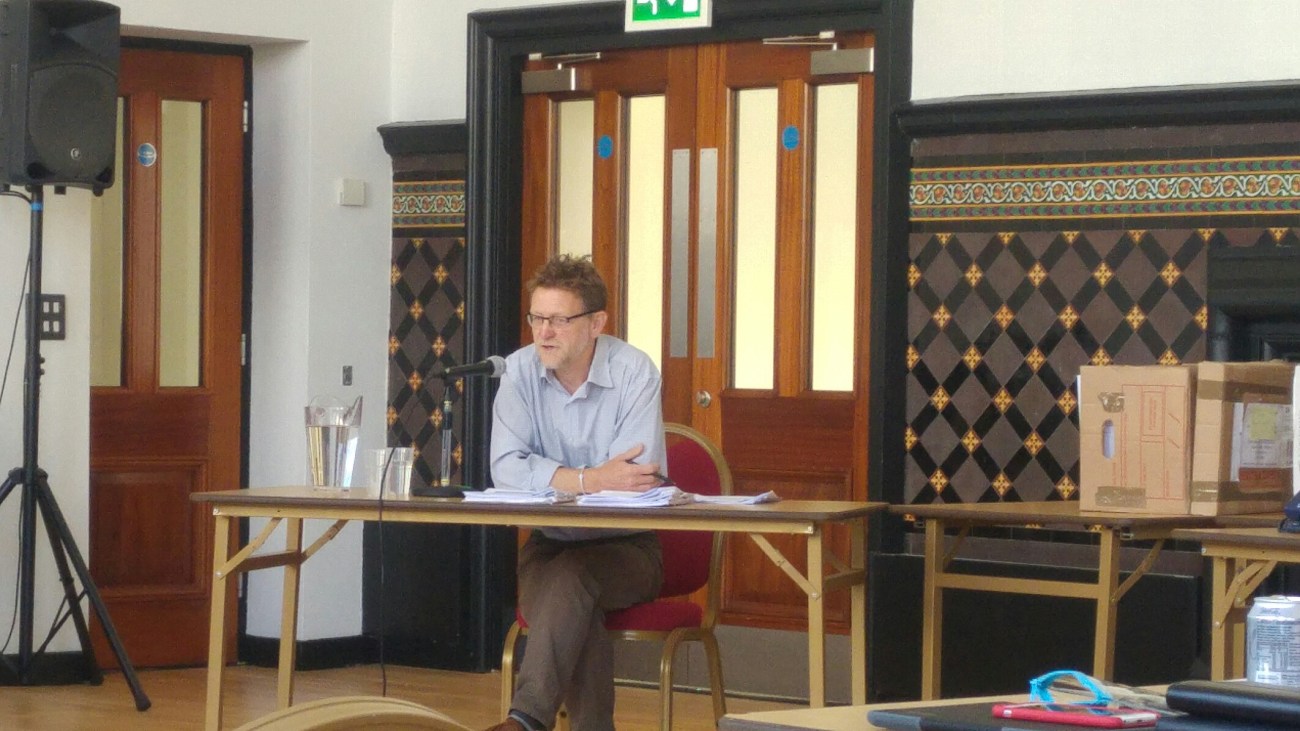
Dr Tickle, Director of CPRE South Yorkshire, gives evidence against the Ineos scheme.
He says:
“Our judgment of the planning balance for this development is that significant local impacts outweigh limited national benefits.”
But he says:
“Should weight be given to the benefits of gas exploration and extraction in
terms of future energy supplies then we consider that proper consideration and
weight must be given in this appeal to counter-evidence on energy security
and the role of gas in helping secure the radical reductions required to meet
legally binding climate change targets”.
Dr Tickle says “there is currently insufficient evidence, either in this
application or appeal, to show that the development in question represents
sustainable development.”
Dr Tickle says CPRE agrees with other evidence that significant harm to the openness of the Green Belt will occur. He says:
“We also concur that the rig and then in particular the associated site infrastructure (including hard standings, bunds, cabins) will urbanise and encroach on the area’s open character over a period of up to five years.
“Although this is temporary in comparison with built development or the duration of many mineral operations, in our view it is substantial enough to cause significant harm, it would not preserve openness and is therefore inappropriate.”
Dr Tickle says:
“There are no very special circumstances that outweigh the impact on the green belt, so the proposed development is contrary to NED saved policy GS2, emerging NED policy SS9 and national policy.”
. Local policies justifiably seek to control harms to landscape and we believe the raft of saved and emerging local policies contravened by this proposal (and cited
fully in our original objection) should carry significant weight.
9.33am: “Disregard Professor Styles’ evidence”
Gordon Steele QC for Ineos says the company has not received a copy of the presentation given by Emeritus Professor Peter Styles. His evidence should be disregarded or given no weight, Mr Steele says. He says his witnesses are disadvantaged because they had not been able to examine the presentation over the weekend.
The Inspector, Elizabeth Hill, says she has not received a paper copy, which was to come to the inquiry venue.
9.30am Inquiry reopens
Inspector, Elizabeth Hill, opens the second week of the inquiry.
Categories: Regulation
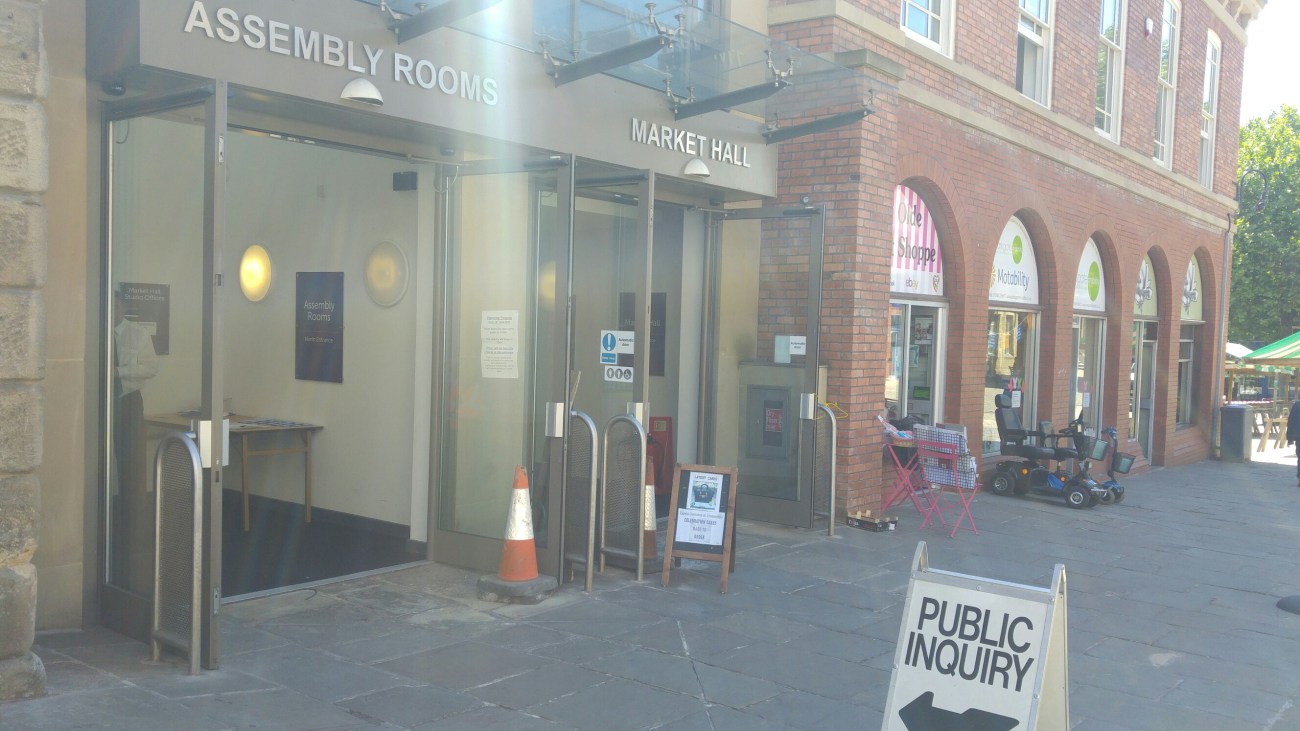

Reblogged this on nearlydead.
Mr Sloan says the regulatory system is based on a goal-setting regime, he says. This is not self-regulation, he adds.
He says the planning system should rely on the advice of the Health and Safety Executive.
This is actually how it plays out. Taken from an FOI between the HSE and Cuadrilla.
“Cuadrilla were looking for some guidance on when a cement bond log was required and who was responsible for the interpretation of the logs. We advised that in a goal setting regime that it was the operator to establish the criteria for when they would run a CBL for surface, intermediate, and production casing. The criteria should be documented and then we could then inspect your operations against this standard”
How exactly is setting your own bar height a ‘ Gold standard’ ? and very very concerning that Cuadrilla had to ask the question.
John Powney
Maybe Cuadrilla have learned a bit since 2011, and have not had a similar conversation for their present wells. It was 7 years ago.
No doubt INEOS have taken note of this issue. As an offshore operator they would perhaps be more au fait with the Regulations than Cuadrilla 7 years ago.
But I am sure you will raise the issue again.
‘Maybe Cuadrilla have learned a bit since 2011’
What an odd thing to say about a company who claims to be experts in the field of fracking. Cement bond logs are cement bond logs regardless of what part of the world you are working in.
Are you suggesting that cement bond logs are new to Cuadrilla?
I will be raising the issue every time I see an article that says we have ‘gold standard’ regulation because clearly there are no ‘gold standards’ with regards to cement bonding which I can assure you is a very serious subject if you care to look it up or would you like me to explain it to you?
John Powney
No need to explain it too me, I am au fait with cement bond logging as well as the UK regulations re drilling and well integrity. Both onshore and offshore.
The point remains that this was 7 years ago.
It would seem that, at that time they were unsure as to uk requirements, not that there was no need for the log.
Good that the HSEx gave them good advice, and they have had time to reflect on it.
So Ineos are going to openly subject local residents to increased noise levels in order to save £1m. Thanks.
Apologies Ruth… But I’m now at the stage where I merely scroll quickly through these particular posts.
The comments via local residents and FoE etc are literally copy and pasted from prior hearings.
The sooner these decisions are taken away from people with vested interest in preventing any form of development the better. A complete waste of tax payers money.
We all know this is going to be accepted.
The whole world has a vested interest in a safer cleaner planet GBH. The climate change issue is real and it takes vigilance to combat the naive and dangerous types of people who play down the risks this industry poses – with either palliative nonsense or downright lies. Methane issues and the leakage is more serious than the ‘venting from a coke bottle’…
https://www.desmogblog.com/2018/06/21/methane-leaks-oil-gas-60-higher-epa-estimates-science-study-edf
So why bother reading, let alone telling us how disappointed you are? Where you there, by the way? [Thank you Ruth for taking the time to be there and report this]
We all know this is going to be accepted – think you said something like this before and did’t get it quite right?
Perhaps you would like to stop being bored and contribute some evidence so we can have a proper debate:
So tell us how shale gas extraction in the UK:
1. Will be economically viable
2. Will provide energy security
3. Is not for plastic
4. Will replace clean renewable energy production
5. Won’t cause seismic activity
6. Won’t pollute ground water
7. Won’t cause property devaluation
8. Will stop imports of gas from conflict areas
9. Is supported by the majority of the UK
10. Will be better than renewables at slowing climate change
Don’t forget, 100% ‘leaves no doubt’ evidence, peer reviewed preferably.
Sherwulfe
In my opinion ….
1….Not yet known
2….See 1
3….I doubt there are any peer reviewed papers to show scientifically that it’s not just for plastic. But we shall see ( ie see point 1 above, but in detail is Cuadrilla in it for the Ethane and is INEOS?. If the wells are prolific but low in Ethane, then it could be all for plastic if both operators bow out citing lack of Ethane. So…see point 1.
4….It’s not support to replace existing or planned renewables? ( did someone say it was ?)
5….By design it causes seismic activity. But how much when under the traffic light system we shall see. See point 1 and the good professors thoughts on the subject.
6… See point 1 for UK. For drilling through aquifers see existing pollution of wells in existing onshore oil fields.
7… It may well do. In that it joins all industrial activity, house building ( as per gov plans ) industry closure, de population ( Lincolnshire ) road building ( next to you, but beneficial a bit further away ) and so on.
8….It depends how much turns up, and the price of gas / development of renewables etc
9… See 1, but doubtful that there is a majority for or against as most are not involved.
10…I am not sure anyone thought it is better per se, just something on the road to more renewables?
Sorry hewes, no banana, but thanks for trying.
To even remotely have a chance at a structured argument for or against shale gas extraction and whether or not the misery caused so far is worth the end game, we need 100% ‘no doubt at all’ evidence
Points of view are not enough; ifs buts and maybes are not enough; ‘depends’ can make anything seem possible but nothing probable.
So still no evidence; keep trying. Am waiting for a comprehensive response, otherwise comments will be classified as pointless PR distraction.
Sherwulfe
Thanks. For most points that 100% evidence here on the UK is yet to come ( whichever way that is ).
The plastic one is a case in point. It’s ifs and buts until the Ethane content is known.
Maybe because most of the points are based on future events, that 100% evidence is elusive, for either side.
So, if that is truly the case where is the justification for this industry? Makes you think, eh?
“Combat the naïve and dangerous types of people”-who claim to have more knowledge via Giggle than those who conduct these operations for a living, being qualified in the subject, and then under the scrutiny of independent supervision and control.
Much as I enjoy a good Giggle, I would prefer to rely upon those who practice what they preach, rather than those who preach what they do not practice.
You see the way it goes. “The whole world-climate change issue is real!” Anyone who speaks for the whole world worries me, and the climate change one is brought forth to try and trump anything of substance. There are numerous Dragon ships hauling gas from US to Europe. Does PhilipP have any clue whether these would continue, or not, if gas was produced from fracking in UK? Or, would they be mothballed?
Read the book yet? (The answer will be no, because some do not want to add to their knowledge, they merely want others to be blinkered from it.)
And you are one of those Martin. Giggle is not a source of reference for anything I point to. Suggesting it is, is just a cheap trick and smear that you thoughtlessness trot out at every opportunity. Those are expert studies (that I link to) to and I bet you haven’t even read them. Your knee-jerk response is Pavlovian and meaningless.
Also, if you are going to use double quote marks as if it is an exact quote of something I say (referring to your second ‘quote’) then please get it right.
Hint – look up Paris agreement re. ‘whole world’ … now minus America, but still with many American States and Cities ignoring Trump and supporting the agreement. England should be globally responsible in this regard too.
Sadly Philip, it looks like many of the bigger countries are going to miss their targets; lip service or stupidity, we will no doubt be an interesting read in the history books of the 22nd century GCSE equivalent, taken by those few remaining in their climate protection pods.
Why don’t Ineos invest in more sustainable energies, i.e tidal and go down in history as a leading energy supplier who has Great Britain at it’s heart rather than a plastics (dirty word) manufacturing company who is happy to stamp it’s ‘BIG BOOTS’ on any who oppose it. By the way I am a tax payer with a lawful vested interest and I am more than happy for my tax to fund these enquiries as it is part of the English legal process……And this comment has not been copy or pasted from prior hearings.
Err, no PhilipP, perhaps you should make better use of Giggle. (Easy for Banks, I believe.)
The whole world, less USA, is nonsense. Much of the rest of the whole world, including the biggest polluters, has no responsibility to actually do anything under the Paris Agreement, other than sign a piece of paper. Perhaps that just might be a major reason why Trump decided against?
You do a great job at demonstrating how easy it is to preach not only what you don’t practice, but even then, to make a mess of the preaching. It certainly isn’t convincing two thirds and the rest of the congregation does seem to be that active at the moment.
History is already proving you wrong Martin. Ignorance of the facts and preaching misleading dogma is not a refuge. The reasons for Trump pulling out was to dismantle all regulations restricting unfettered expansion of oils and gas development. This has been so brazen and so obvious to all except, evidently, those with heads buried deep in the sand – or tarpits.
Fracking near schools. Utterly despicable. £££££ signs. I certainly would not send my child to a school near a fracking site. Not scaremongering, its hundreds of scientific papers on the health impacts associated with proximity to fracking sites.